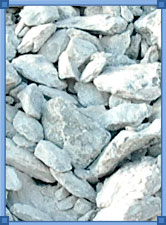Steatite, Talc, French Chalk of Soapstone is the softest and one of the most important industrial minerals in the world found in rocks formed over many millions of years. It is a hydrated magnesium silicate with the chemical formula Mg3Si4O10(OH)2. It is also written as H2Mg3(SiO3)4, which corresponds to 4.8% H2O; 31.7% MgO and 63.5% SiO2. |
| |
| Chemical Formula : Mg3Si4O10(OH)2 |
| |
Chemical Composition |
| |
| Component |
Percentage |
| MgO |
31% |
SiO2 |
60% |
| Al2O3 |
0.5% |
| CaO |
0.1% |
| FeO |
2.1% |
| Fe acid soluble (1M HCl, 100'C) |
0.2% |
| Loss on ignition |
5.8% |
| Water solubles |
0.1% |
|
| |
| |
| |
|
Characteristics of Talc |
| |
| |
- Talc is neither explosive nor flammable.
- Although it has very little chemical reactivity, talc does have a marked affinity for certain organic chemicals, i.e. it is organophilic.
- It is practically insoluble in water and is chemically inert to acids and alkalies.
 It can withstand temperatures upto 1300ºC and its melting point is at 1500°C. It can withstand temperatures upto 1300ºC and its melting point is at 1500°C.- It has low electrical and thermal conductivity.
- Above all it can be easily powdered, cut and sawn into any shape and size.
- It possesses lubricating properties, high luster and sheen chemical inertness, high fusion point, low conductivity to heat and electricity and hiding power as pigment extender.
- The color of the material varies from pure white to silvery white, gray, green and yellow.
These properties in talc are of extreme value for various industrial applications.
It is valued for its extreme softness, smoothness, high lubricating and hiding power and ability to absorb oil and grease. It has also been found to be excellent filler. |
| |
| |
| |
|
Formation and Occurrence of Talc
It is essentially a secondary mineral formed by the hydrothermal actions and regional metamorphism of magnesium rich rocks like dolomite, pyroxenite, amphibolite, seerpentine, dunite and chlorite.
It occurs usually intimately associated with magnesium-rich minerals. Anthophyllite, termolite, diopside, dolomite, sometimes quartz and calcite are the common minerals found in association with talc. It is found as soft mass in the forms of bands, lenses and vein-like bodies enclosed in dolomite country rock. Veins vary from small in dimensions to very large, usually 25-40 metres long and 12-18 metres wide. It has been mined up to a depth of 20 metres. Lenses of soapstone are separated by dolomite and also dolomite is found enclosed within the soapstone mass. It is of compact variety. |
| |
Applications of Talc |
| |
 |
| |
|
|
|
 |